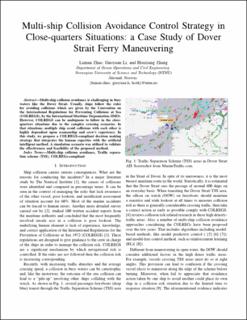| dc.contributor.author | Zhao, Luman | |
| dc.contributor.author | Li, Guoyuan | |
| dc.contributor.author | Zhang, Houxiang | |
| dc.date.accessioned | 2021-01-14T13:35:57Z | |
| dc.date.available | 2021-01-14T13:35:57Z | |
| dc.date.created | 2020-10-29T22:49:45Z | |
| dc.date.issued | 2020 | |
| dc.identifier.isbn | 978-1-7281-5413-8 | |
| dc.identifier.uri | https://hdl.handle.net/11250/2723123 | |
| dc.description.abstract | Multi-ship collision avoidance is challenging in busy waters like the Dover Strait. Usually, ships follow the rules for avoiding collisions which are given by the Convention on the International Regulations for Preventing Collisions at Sea (COLREGS), by the International Maritime Organization (IMO). However, COLREGS can be ambiguous to follow in the close-quarters situations due to the complex crossing scenarios. In that situations, multiple ship avoid collisions with each other is highly dependent upon seamanship and crew’s experience. In this study, we propose a COLREGS-compliant decision making strategy that integrates the human expertise with the artificial intelligent method. A simulation scenario was utilized to validate the effectiveness and feasibility of the proposed method. | en_US |
| dc.language.iso | eng | en_US |
| dc.publisher | Institute of Electrical and Electronics Engineers (IEEE) | en_US |
| dc.relation.ispartof | The 46th Annual Conference of the IEEE Industrial Electronics Society (IECON 2020) | |
| dc.title | Multi-ship collision avoidance control strategy in close-quarters situations: a case study of Dover Strait ferry maneuvering | en_US |
| dc.type | Chapter | en_US |
| dc.description.version | acceptedVersion | en_US |
| dc.source.pagenumber | 303-309 | en_US |
| dc.identifier.doi | 10.1109/IECON43393.2020.9255182 | |
| dc.identifier.cristin | 1843419 | |
| cristin.ispublished | true | |
| cristin.fulltext | postprint | |
| cristin.qualitycode | 1 | |
